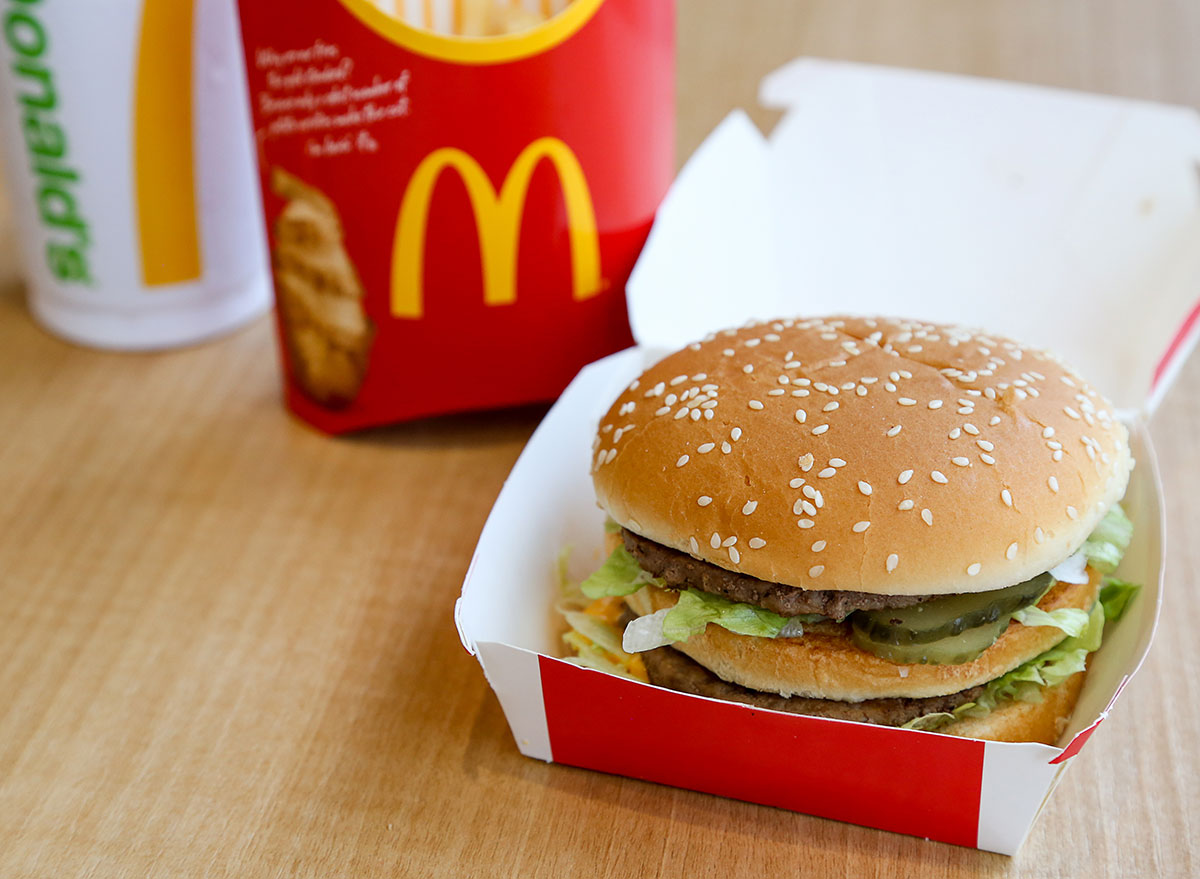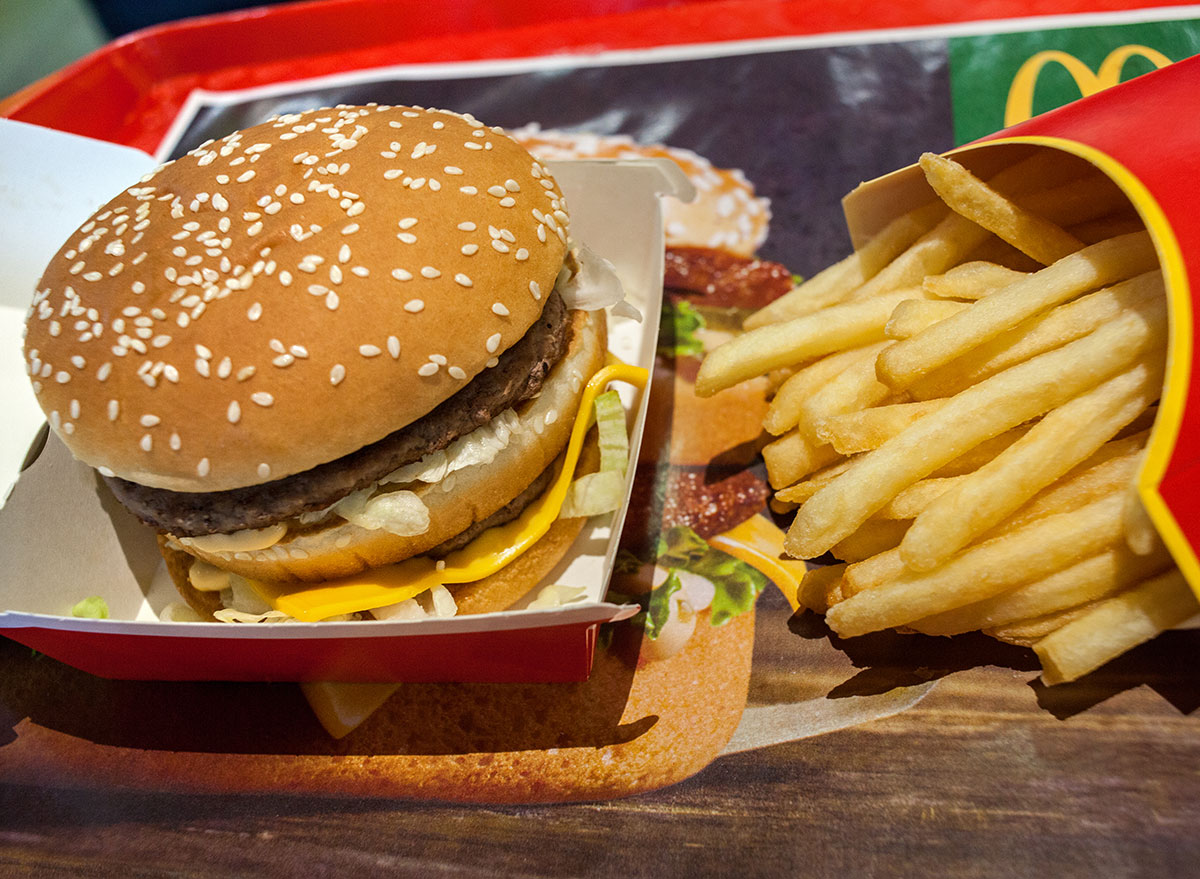17 Crazy Facts About the Big Mac You Never Knew

The Big Mac may not be the most gourmet burger out there, but it's definitely one of the most popular fast food items around. Whether you're in the United States or almost anywhere around the world, you can count on being able to score some version of the legendary sandwich if you see McDonald's famous Golden Arches. The Big Mac has been a staple for more than 50 years, and it's not going away anytime soon. But how much do you actually know about the legend behind the burger?
Even if you've eaten a fair number of Big Macs, there's a chance you might not know some of the details behind its history. Take for example how the Big Mac was almost named the "Big Mc." Seriously! And it wasn't even a national menu item to begin with! We rounded up a few facts about the Big Mac for you to discover, because it never hurts to know a little more about your favorite classic foods (hey, they must be classics for a reason, right?).
It was invented by a McDonald's franchisee in Pittsburgh.

As Adweek explains, McDonald's corporate didn't actually come up with the Big Mac, as it wasn't even an item served nationally during those early days. Jim Delligatti created the now-famous burger in 1967 in Pittsburgh, complete with two patties, special sauce, lettuce, cheese, onions, pickles, and an extra bun slice in the middle. In 1968, McDonald's then took the Big Mac nationwide.
Delligatti originally called the sandwich the "Big Mc."

Even though it's closer to the McDonald's name—as well as some of the chain's other offerings, like the McRib or Egg McMuffin—"Big Mc" just doesn't have the same ring to it, so Delligatti decided to make a tiny tweak to the name. "Big Mac" rolls off the tongue, so Delligatti went with that for the name of his creation instead, Adweek notes.
McDonald's created an updated version of Delligatti's "special sauce" recipe in 1972.

As the fast food chain explains on its website, the company discovered that after it took Delligatti's creation nationwide, there were two versions of the sauce going around, so they combined them into a new recipe, Big Mac Sauce '72. Then, in 1974, the term "Special Sauce" was coined.
In 1986, The Economist created the "Big Mac Index."

The so-called "Big Mac Index" is used to measure currency exchange rates and "whether currencies are at their 'correct' level," the magazine notes. After all, Big Macs span plenty of countries and cultures, so using it as the benchmark for this money-measuring system kind of makes perfect sense, doesn't it?
It's spawned plenty of international versions.

If you happen to order one of these hefty burgers outside of the United States, there's a good chance you're going to be treated to a unique variation of the burger. McDonald's doesn't sell beef in India, The Guardian explains, so the country's burger offerings focus on different types of meat. The Maharaja Mac uses mutton rather than beef patties.
Australia, meanwhile, offers a lighter version of the Big Mac. The Son of Mac is a single-patty version that doesn't have a bun slice in the center, which makes for a bit of a messier sandwich while doing away with the sandwich's double decker style.
There's a sister burger, the McKinley Mac, that's only available in Alaska.

The McKinley Mac uses Quarter Pounder patties, which are larger than the traditional Big Mac patties, so if you're looking for an even bigger sandwich, Alaska has you covered. It's the perfect reason to plan a trip now, right?
McDonald's marked the Big Mac's 50th anniversary by making limited-edition "MacCoins."

In August of 2018, McDonald's released "MacCoins," which were given to customers when they purchased Big Macs. The coins could then be traded in for another sandwich, free of charge.
There was actually a different "Special Sauce" recipe from 1991 until 2004.

If you noticed a slight change in taste when it came to your Big Mac's sauce during that time, you're not wrong. McDonald's explains that the company attempted to "tweak" the recipe in 1991. But in 2004, McDonald's CEO Fred Turner decided the Special Sauce should be reverted back to its original recipe, so there are some people out there who have tasted two variations of the Special Sauce. We wonder which one they prefer?
McDonald's revealed the Big Mac's "Special Sauce" recipe in 2012.

Until recently, McDonald's was fairly tight-lipped about their sauce—even if its ingredients were technically available in the fine print of its nutritional info. In 2012, though, the company released a video showing McDonald's executive chef making a recipe that's similar to the Special Sauce served in its restaurants. The recipe includes mayonnaise, yellow mustard, white wine vinegar, relish, garlic powder, paprika, and onion powder. There are plenty of copycat recipes out there too for making your own "Special Sauce" at home if you want to give it a go.
The Big Mac isn't McDonald's most popular item.

It might be the fast-food chain's biggest celebrity on the menu, but it's not the go-to item for everyone that rolls up to the drive-thru window, though. The top honor of the best-selling item of all time goes to the chain's french fries. There are still plenty of people ordering Big Macs, though—the burger was the chain's second-most-popular item.
There's a Big Mac Museum Restaurant in Pennsylvania.

In honor of the state where the Big Mac was created, fans can visit some burger-themed attractions at this North Huntingdon location. Some of the draws include "the world's tallest Big Mac statue"—which is likely one of the world's only Big Mac statues—as well as "historic memorabilia" about the iconic sandwich.
Americans eat 550 million Big Macs each year.

According to Adweek, about 17 Big Macs are eaten each second in the United States. That's a lot of burgers to go around when you think about how many seconds are in just one day.
The Big Mac originally cost just 45 cents.

The prices have gone up since 1967 when Delligatti first charged 45 cents for his double-decker creation. Big Mac devotees, no doubt, will likely tell you that the burger is still worth its current price, no matter what it costs. In case you were wondering, the Big Mac by itself (not a full meal, mind you) comes in at around $4, although each state varies.
There are a lot of seeds on Big Mac buns.

According to Adweek, there are about 400 seeds on every Big Mac burger. The sesame-laden buns distinguish the Big Mac from some of McDonald's other burger offerings, as well as from the burgers at its fast-food competitors.
McDonald's released a Sriracha Mac Sauce in 2016.

McDonald's Special Sauce is one of the Big Mac's main claims to fame, but in 2016, the fast-food chain decided to switch things up and release a Sriracha Mac Sauce. It was tested in Ohio before becoming a nationwide offering. Sadly, though, the Signature Sriracha Burger, which featured the updated sauce, was a limited-time offering.
The Big Mac was originally created to feed steel mill workers.

In an obituary for Delligatti, who died in 2016, Business Insider explains that he originally created the two-patty burger to feed hungry steel mill workers. They came into his McDonald's franchise after their shifts, and the single-patty burgers evidently weren't enough to refuel them. The double-patty turned out to be a game-changer.
Pittsburgh was named Big Mac City, USA, in 1993.

In honor of the sandwich's 25th anniversary, Sophie Masloff, Pittsburgh's mayor at the time, called Pittsburgh "Big Mac City, USA." She announced the new name during an official ceremony, at which Delligatti himself was present. You can't really seem to top that, can you?








